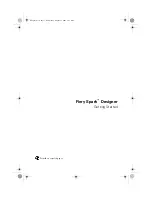
98 Visual C++ object definitions
CHostData object
BSTR FirstConnectionType(); and BSTR
NextConnectionType();
FirstConnectionType() and NextConnectionType() are used to iterate through
the available connection types. The functions return a BSTR, which is the name
of an available connection type. You can use these returned connection types
with the SetConnectionType() function.
Table 3-50
defines the return value.
BOOL FindConnectionType(LPCTSTR lpszConnectionType);
Returns TRUE if the connection type that is passed in exists on the computer.
Table 3-51
defines the parameter.
Table 3-52
defines the return value.
short MaxAssignedConnections()
Returns the maximum number of connection types that can be assigned at the
same time (currently two).
Table 3-53
defines the return value.
Table 3-50
BSTR FirstConnectionType(); and BSTR NextConnectionType();
return value
Return value
Description
BSTR
The name of a supported connection device type
Table 3-51
BOOL FindConnectionType parameter
Parameter
Description
LPCTSTR lpszConnectionType
The name of a connection device type
Table 3-52
BOOL FindConnectionType return value
Return value
Description
BOOL
TRUE if this device type is available
Table 3-53
short MaxAssignedConnections() return value
Return value
Description
Short
The maximum number of connection type
assignments
Summary of Contents for PCANYWHERE - OLE AUTOMATION GUIDE V12.1
Page 1: ...Symantec pcAnywhere OLE Automation Guide ...
Page 6: ......
Page 18: ...18 Using OLE Automation with Symantec pcAnywhere Where to find more information ...
Page 68: ...68 Visual Basic object definitions Awrem32 functions ...
Page 108: ...108 Visual C object definitions Awrem32 functions ...
Page 112: ...112 Index ...















































